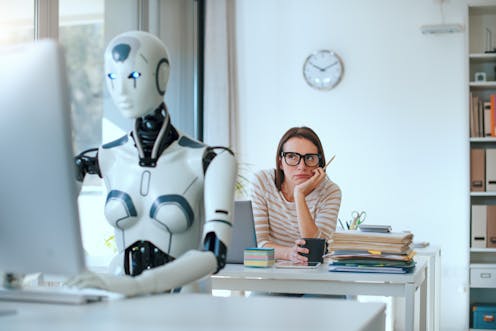
Two influential tech CEOs have sparked a debate about AI’s effect on jobs. Klarna CEO Sebastian Siemiatkowski announced the buy-now, pay-later firm stopped hiring a year ago, claiming that AI can do most of the jobs that humans do. And the chief executive of AI firm Nvidia, Jensen Huang, has argued that workers are not going to lose their jobs to AI – but they could lose it to somebody who uses AI.
These opposing views capture a crucial tension as generative AI rapidly transforms workplaces. But research suggests the reality is more complex than either complete job displacement or simple augmentation.
As of spring 2024, 66% of employment in the US was exposed to a high or moderate level of generative AI impact, with the remaining 34% of jobs still affected in secondary tasks. Unlike previous technological revolutions, generative AI is being adopted at an unprecedented pace, outstripping the adoption rates of personal computers and the internet.
What makes this transformation particularly significant is that generative AI is disrupting a different array of “cognitive” and “non-routine” tasks, especially in middle- to higher-paid professions. This marks a departure from previous waves of automation that primarily affected routine manual labour. With the constantly evolving generative AI landscape, this trend is likely to continue and strengthen.
Research provides insights into how AI is actually affecting worker productivity and job security. One of the first comprehensive studies examined the effect of AI-powered conversational assistants on customer support agents. The findings challenge both the utopian and dystopian visions of AI’s impact.
The study found that access to AI tools increased worker productivity by an average of 14%. However, the benefits weren’t distributed equally. Novice and low-skilled workers saw the most dramatic improvements, with productivity gains of up to 35%. The AI effectively helped newer workers quickly adopt the techniques of high-performing agents.
Surprisingly, highly skilled workers saw minimal productivity gains from the AI tools. This suggests that rather than replacing human expertise, AI might help to make things more equal by elevating the capabilities of less-experienced workers.
Klarna’s experiment
Against this backdrop, Klarna’s approach of ceasing hiring and allowing natural workforce attrition represents a bold experiment. Siemiatkowski’s claim that AI can replace most human jobs aligns with concerns about widespread job displacement.
However, the company’s strategy of increasing salaries for remaining workers suggests a more nuanced reality: even as AI automates certain tasks, human expertise becomes more valuable, not less. This aligns with research showing that organisations need workers who can use AI tools effectively.

The perspective of Nvidia CEO Huang – that people will lose jobs to AI users rather than AI itself – finds support in emerging workplace trends. A KPMG survey of US executives found that while administrative jobs face significant risk from AI, the effects vary widely across sectors. In manufacturing, for instance, 20% of respondents expect benefits from AI, while 24% anticipate negative effects.
This suggests that rather than wholesale replacement of workers, it’s likely to be a transformation of roles. The key factor in job security may not be whether a role can be automated, but whether workers and organisations can effectively integrate AI tools into their workflows.
Crucially, researchers studying ChatGPT adoption in Denmark found that half of the workers surveyed have used the generative AI tool. Younger, less-experienced, higher-achieving, and especially male workers were leading adoption. The study suggests that while workers see substantial productivity potential in ChatGPT, employer restrictions and a need for training are hindering its full adoption; it does not appear that workers fear job redundancy as a reason for avoiding the technology.
The evidence points to several strategies for workers and organisations navigating this transition.
1. The importance of lifelong learning
Workers need to continuously update their skills, focusing particularly on capabilities that complement AI, such as critical thinking and complex problem-solving.
2. The value of AI literacy
Understanding how to use AI tools effectively is becoming as crucial as traditional job skills.
3. The need for organisations to adapt
Companies must invest in employee training and development while implementing clear guidelines for AI use.
The rapid adoption of generative AI means these changes are happening faster than previous technological transformations. Workers and organisations that adapt quickly will probably have significant advantages over those that delay.
x
The contrasting views of Siemiatkowski and Huang represent different possibilities in our AI-augmented future. The evidence suggests neither complete displacement of human workers nor business-as-usual is likely. Instead, we’re entering a period where the ability to work alongside AI will increasingly determine career success.
Early evidence suggesting that AI can help level the playing field for less experienced workers is encouraging. But perhaps the most important lesson from both CEOs’ predictions is this: while we can’t control how AI will transform industries, we can control how well we adapt to it.
In this new landscape, the key to job security isn’t fighting AI or passively accepting it – it’s actively choosing to become the person using AI rather than the person being replaced by someone who does.
![]()
Marcel Lukas receives funding from The British Academy. He is a Fellow with the Office for National Statistics (UK) and Director of Executive Education at the University of St Andrews.



